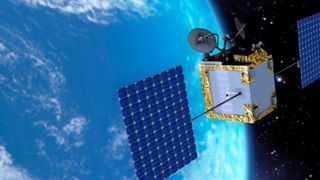Ericsson, Qualcomm, and Thales are taking 5G to space
Space 5G could boost global connectivity and provide useful backup

Ericsson, Qualcomm, and Thales plan to bring 5G connectivity to low earth orbit (LEO) satellite constellations, potentially expanding coverage of next-generation mobile networks to remote or previously unreachable parts of the planet.
The three companies have conducted a series of studies and simulations to ascertain the feasibility of such a project and are now ready to stage smartphone use case testing and validation of 5G non-terrestrial networks (5G NTN).
3GPP, the global standards body, is giving its support for non-terrestrial networks for the first time and if the trials are successful, future 5G smartphones could include native support for 5G NTN, effectively making them satellite phones.
5G in space
Several companies, including the British government backed OneWeb and Elon Musk’s Starlink, are building LEO constellations that offer much faster, lower latency connectivity than legacy satellite technologies.
This is paving the way for more advanced satellite broadband offerings that rival even fixed connectivity. The addition of 5G into the mix would provide another option for operators, businesses and the public sector.
In addition to expanding coverage to oceans, mountains, and deserts, 5G NTN would boost international roaming and offer a backup if there is a major network outage or natural disaster. Government communications would be another potential use case given the security characteristics of 5G.
“This testing and validation cooperation between Ericsson, Thales and Qualcomm Technologies will be a major milestone in the history of communications as the ultimate result could effectively mean that no matter where you are on Earth – in the middle of an ocean or the remotest forest – high-end, secure and cost-effective connectivity will be available through collaborative 5G satellite and terrestrial connectivity,” said Erik Ekudden, Ericsson CTO.
Are you a pro? Subscribe to our newsletter
Sign up to the TechRadar Pro newsletter to get all the top news, opinion, features and guidance your business needs to succeed!
The goal of the next phase of testing is to validate the various technologies needed to enable 5G NTN. This includes the smartphone, the satellite payload, and the terrestrial networking components.
Ericsson will use virtual radio access network (vRAN) technology to handle radio signals from space, while Qualcomm will provide test phones and Thales plans to verify a radio satellite payload. Testers will then emulate the 5G radio propagation and the time delays between the satellites and testing equipment.
“While it is too early to say when any resulting 5G equipped prototype satellite could be launched into orbit for real operational use, the highly technical ground-based testing and validation work planned between Ericsson, Thales and Qualcomm Technologies is key to making it happen,” added Ekudden.
- We've picked out some of the best mobile phone deals
Steve McCaskill is TechRadar Pro's resident mobile industry expert, covering all aspects of the UK and global news, from operators to service providers and everything in between. He is a former editor of Silicon UK and journalist with over a decade's experience in the technology industry, writing about technology, in particular, telecoms, mobile and sports tech, sports, video games and media.
